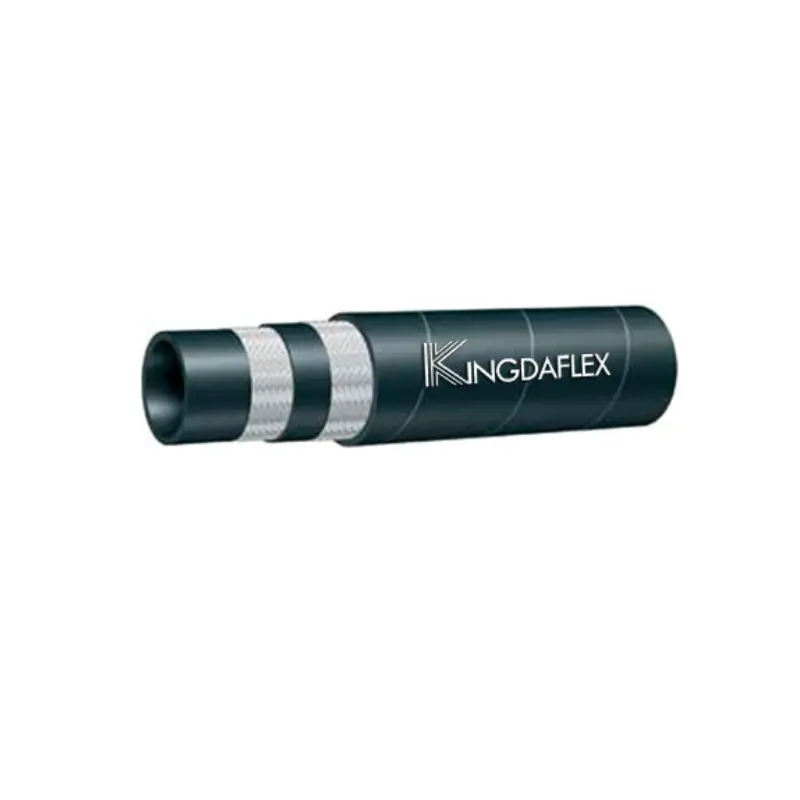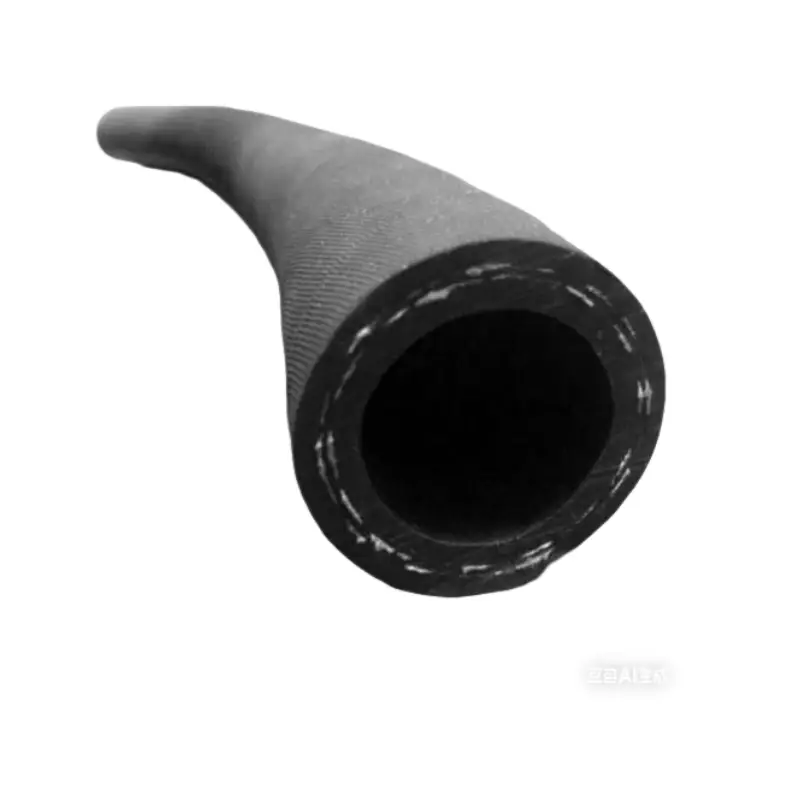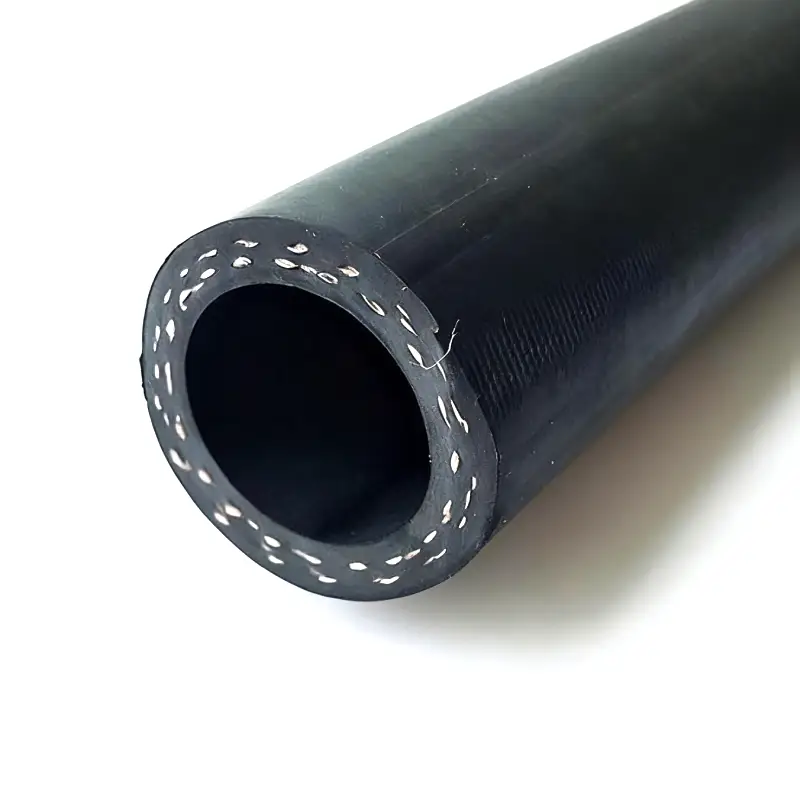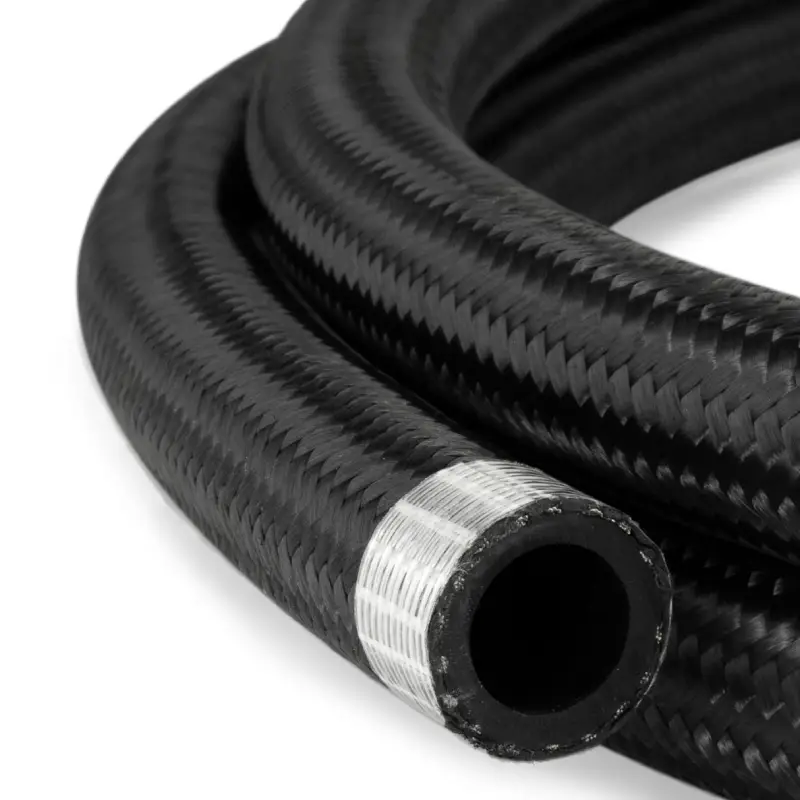We offer textile braided hoses designed for durability, flexibility, and reliable performance in various industrial applications. These hoses provide safe fluid transfer, resist pressure, and withstand demanding operational conditions, making them ideal for hydraulic systems, machinery, and equipment requiring flexible yet strong hose solutions.
Durable Construction: Our hoses feature high-strength textile braiding that enhances resistance to pressure, wear, and mechanical stress. We ensure longevity, reliable operation, and consistent performance under demanding industrial conditions.
Flexibility: Designed for easy handling and installation, our textile braided hoses bend smoothly without kinking. We provide solutions that adapt to complex routing and tight spaces while maintaining efficient fluid flow.
High-Pressure Resistance: These hoses can withstand elevated pressures in hydraulic and fluid transfer systems. We ensure safety and durability by selecting appropriate materials and braiding techniques for high-performance applications.
Versatile Applications: Suitable for industrial, machinery, and hydraulic systems, our hoses support a wide range of fluid transfer tasks. We provide reliable performance across diverse operational environments and requirements.
Easy Maintenance: Our textile braided hoses are simple to inspect, clean, and maintain. We design them for minimal downtime, ensuring continuous operation and long-term reliability in various industrial processes.
We are a top manufacturer of textile braided hoses in China, providing durable and flexible solutions for industrial and hydraulic applications. Our hoses are designed to withstand high pressure, abrasion, and continuous use, ensuring reliable fluid transfer and long-lasting performance. With strict quality control and customized options, we meet diverse operational requirements efficiently.

Inner Tube: The inner tube is made of high-quality synthetic rubber or thermoplastic material. It ensures smooth fluid flow, resists chemical corrosion, and withstands high temperatures for long-lasting operation.
Textile Braided Reinforcement: High-strength textile fibers are braided around the inner tube. This layer provides pressure resistance, mechanical strength, and flexibility, preventing hose deformation during demanding industrial and hydraulic applications.
Outer Cover: The outer cover is crafted from abrasion- and weather-resistant rubber. It protects the hose from external damage, UV exposure, and mechanical wear while ensuring long-term durability.
Optional Additives: Some hoses include chemical- or oil-resistant additives in the rubber. These enhance performance under specific operational conditions, improving resistance to harsh fluids, environmental factors, and mechanical stress.
High Pressure Resistance: Our hoses withstand high operating pressures due to the braided textile reinforcement, ensuring reliable performance and safety during continuous hydraulic or fluid transfer applications.
Flexibility: Textile braided hoses offer excellent bending and routing capabilities. We design them to navigate tight spaces, reducing kinks and improving ease of installation in complex systems.
Durability: The combination of inner tube, braided reinforcement, and outer cover provides long-lasting durability. Our hoses resist wear, abrasion, and mechanical stress for extended operational life.
Chemical and Oil Resistance: Many hoses include additives to resist chemicals and oils. We ensure hoses maintain performance in harsh industrial environments and withstand fluid-related degradation.
Versatile Applications: Suitable for hydraulic systems, machinery, and industrial fluid transfer, these hoses provide dependable performance across various operational conditions, supporting diverse industrial needs efficiently.

We manufacture all types of textile braided hoses, designed for durability, flexibility, and reliable performance in industrial and hydraulic applications. Our hoses withstand high pressure, abrasion, and continuous use, ensuring smooth fluid transfer and long-lasting operation. With customizable options and strict quality control, we provide solutions that meet diverse operational requirements efficiently and safely.

We offer textile braided rubber hoses designed for reliable and flexible fluid transfer in industrial and hydraulic applications. Our hoses handle high pressure, resist abrasion, and maintain consistent performance under continuous use. We provide a range of sizes and specifications to meet various operational needs, ensuring efficient and durable hose solutions.

We offer textile braided hydraulic hoses designed for reliable fluid transfer in industrial and hydraulic systems. Our hoses provide flexibility, durability, and pressure resistance, ensuring smooth operation in demanding applications. We supply a range of sizes and specifications to meet different equipment requirements, supporting efficient performance and long-lasting use in various hydraulic setups.

We offer textile-covered braided hoses designed for durability, flexibility, and reliable fluid transfer in various industrial and hydraulic applications. Our hoses resist pressure, abrasion, and continuous use while providing smooth flow. We provide a range of sizes and specifications to meet different operational needs, ensuring efficient and safe performance in demanding environments.
We understand that every industrial or hydraulic application has unique requirements. That’s why we offer fully customizable textile braided hoses to ensure optimal performance and reliability. From material selection to reinforcement, we work closely with our clients to provide solutions that meet specific operational needs and environmental conditions.
We help you choose the right inner tube and outer cover materials based on fluid type, temperature, and operating conditions. By selecting materials that balance flexibility and strength, we ensure the hose performs reliably while resisting wear, chemical exposure, and mechanical stress.
We allow customization of hose diameter and length to match your machinery and workflow requirements. Proper sizing ensures optimal flow, reduces pressure loss, and makes handling easier. Our tailored approach guarantees the hose fits your operational layout efficiently and safely.
We provide options for customizing the textile braided reinforcement. By selecting the right fiber type, braid pattern, and layer thickness, we enhance pressure resistance, flexibility, and durability. This ensures the hose withstands continuous operation and maintains structural integrity under demanding conditions.
We help determine the ideal flexibility and bend radius for your hose to navigate tight spaces or complex layouts. By adjusting these parameters, we prevent kinks, maintain smooth flow, and improve handling, ensuring safe and efficient operation in all applications.
A textile braided hose is a flexible hose reinforced with high-strength textile fibers woven around the inner tube. This construction provides durability, pressure resistance, and flexibility, making it suitable for hydraulic, industrial, and fluid transfer applications. The braided reinforcement prevents deformation under high pressure while maintaining smooth flow.
These hoses are widely used in machinery, hydraulic systems, and industrial equipment where reliable fluid transfer is essential. They can handle various fluids, resist mechanical stress, and adapt to complex layouts. Textile braided hoses combine strength, flexibility, and durability, offering a dependable solution for demanding operational environments.
Textile braided hoses are constructed with multiple layers designed to provide strength, flexibility, and durability. Each layer has a specific function, ensuring safe and efficient fluid transfer in hydraulic and industrial applications. The combination of materials allows the hose to withstand pressure, abrasion, and mechanical stress.
Inner Tube: The inner tube is made of synthetic rubber or thermoplastic material. We ensure it resists chemical corrosion, maintains smooth fluid flow, and withstands high temperatures, providing reliable performance and long-lasting operation in various industrial and hydraulic systems.
Textile Braided Reinforcement: High-strength textile fibers are braided around the inner tube. We design this layer to resist internal pressure, mechanical stress, and deformation while maintaining flexibility, ensuring durability and safety during demanding fluid transfer operations.
Outer Cover: The outer cover is crafted from abrasion- and weather-resistant rubber. We ensure it protects the hose from external damage, UV exposure, and environmental wear, extending the hose’s operational life and maintaining consistent performance.
Optional Additives: Some hoses include chemical-, oil-, or heat-resistant additives in the rubber. We incorporate these to improve performance in harsh environments, enhancing resistance to fluid degradation, mechanical wear, and extreme operational conditions for long-term reliability.
Textile braided hoses are widely used in industrial, hydraulic, and fluid transfer applications. Their durability, flexibility, and pressure resistance make them suitable for transferring liquids, oils, and chemicals safely and efficiently. These hoses support smooth operation and long-lasting performance in demanding environments.
Hydraulic Systems: Used to transfer hydraulic fluids in machinery and equipment. We ensure hoses withstand high pressure, resist mechanical stress, and maintain consistent flow, supporting efficient and safe operation in various industrial and construction applications.
Industrial Fluid Transfer: Applied in factories and production lines for moving water, oils, chemicals, and other fluids. We design hoses to resist abrasion, temperature fluctuations, and chemical exposure, ensuring reliable performance in continuous industrial operations.
Machinery and Equipment: Used in engines, pumps, and mechanical systems requiring flexible fluid connections. We ensure hoses maintain integrity under vibration, bending, and pressure, providing durability and efficiency in demanding operational conditions.
Automotive Applications: Suitable for fuel lines, coolant systems, and other automotive fluid transfer tasks. We provide hoses capable of withstanding heat, pressure, and chemical exposure while maintaining safety and consistent performance in vehicles.
Agricultural and Construction Equipment: Used in irrigation systems, hydraulic machinery, and construction equipment. We ensure hoses handle abrasive fluids and high-pressure conditions, providing reliable and long-lasting service in rugged outdoor environments.
Textile braided hoses must be used correctly to ensure safe, efficient, and long-lasting performance. Proper installation, handling, and maintenance prevent leaks, kinks, and damage. Following recommended procedures ensures smooth fluid transfer and reliable operation in hydraulic, industrial, and machinery applications.
Correct Installation: Always connect hoses to compatible fittings and ensure proper alignment. We recommend avoiding twists or sharp bends, as proper installation reduces stress, prevents leaks, and maintains smooth fluid flow throughout hydraulic or industrial systems.
Pressure Monitoring: Ensure operating pressures remain within hose specifications. We advise monitoring pressure levels continuously to prevent overloading, which could cause hose failure, leaks, or reduced performance during high-pressure operations.
Avoid Kinking and Twisting: Handle hoses carefully during installation and use to prevent kinks or twists. We ensure hoses maintain their shape and flow efficiency, minimizing damage and extending service life in demanding industrial or hydraulic environments.
Regular Inspection: Inspect hoses for wear, cracks, or leaks before and after use. We recommend checking reinforcement layers, fittings, and outer covers to detect early issues, preventing operational downtime and costly repairs.
Proper Storage: Store hoses in a cool, dry area, avoiding direct sunlight or contact with sharp objects. We ensure hoses retain flexibility, prevent deformation, and remain ready for safe, efficient use in future operations.
A textile braided hose is a flexible hose reinforced with high-strength textile fibers woven around the inner tube. This construction provides durability, pressure resistance, and flexibility, making it suitable for hydraulic, industrial, and fluid transfer applications. The braided reinforcement prevents deformation under high pressure while maintaining smooth flow.
These hoses are widely used in machinery, hydraulic systems, and industrial equipment where reliable fluid transfer is essential. They can handle various fluids, resist mechanical stress, and adapt to complex layouts. Textile braided hoses combine strength, flexibility, and durability, offering a dependable solution for demanding operational environments.
Textile braided hoses are constructed with multiple layers designed to provide strength, flexibility, and durability. Each layer has a specific function, ensuring safe and efficient fluid transfer in hydraulic and industrial applications. The combination of materials allows the hose to withstand pressure, abrasion, and mechanical stress.
Inner Tube: The inner tube is made of synthetic rubber or thermoplastic material. We ensure it resists chemical corrosion, maintains smooth fluid flow, and withstands high temperatures, providing reliable performance and long-lasting operation in various industrial and hydraulic systems.
Textile Braided Reinforcement: High-strength textile fibers are braided around the inner tube. We design this layer to resist internal pressure, mechanical stress, and deformation while maintaining flexibility, ensuring durability and safety during demanding fluid transfer operations.
Outer Cover: The outer cover is crafted from abrasion- and weather-resistant rubber. We ensure it protects the hose from external damage, UV exposure, and environmental wear, extending the hose’s operational life and maintaining consistent performance.
Optional Additives: Some hoses include chemical-, oil-, or heat-resistant additives in the rubber. We incorporate these to improve performance in harsh environments, enhancing resistance to fluid degradation, mechanical wear, and extreme operational conditions for long-term reliability.
Textile braided hoses are widely used in industrial, hydraulic, and fluid transfer applications. Their durability, flexibility, and pressure resistance make them suitable for transferring liquids, oils, and chemicals safely and efficiently. These hoses support smooth operation and long-lasting performance in demanding environments.
Hydraulic Systems: Used to transfer hydraulic fluids in machinery and equipment. We ensure hoses withstand high pressure, resist mechanical stress, and maintain consistent flow, supporting efficient and safe operation in various industrial and construction applications.
Industrial Fluid Transfer: Applied in factories and production lines for moving water, oils, chemicals, and other fluids. We design hoses to resist abrasion, temperature fluctuations, and chemical exposure, ensuring reliable performance in continuous industrial operations.
Machinery and Equipment: Used in engines, pumps, and mechanical systems requiring flexible fluid connections. We ensure hoses maintain integrity under vibration, bending, and pressure, providing durability and efficiency in demanding operational conditions.
Automotive Applications: Suitable for fuel lines, coolant systems, and other automotive fluid transfer tasks. We provide hoses capable of withstanding heat, pressure, and chemical exposure while maintaining safety and consistent performance in vehicles.
Agricultural and Construction Equipment: Used in irrigation systems, hydraulic machinery, and construction equipment. We ensure hoses handle abrasive fluids and high-pressure conditions, providing reliable and long-lasting service in rugged outdoor environments.